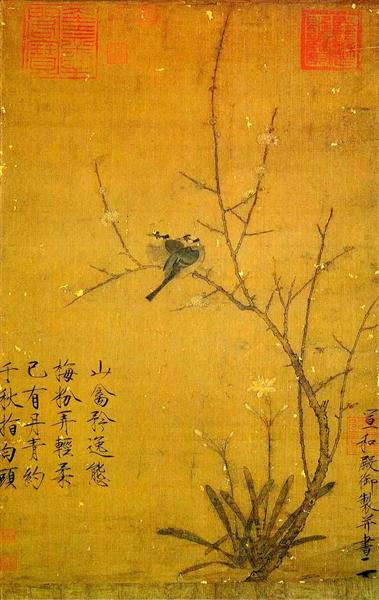Description
In a deep contemplation of Chinese ancient art, the painting "plum and birds" (Plum and Birds) of Emperor Huizong stands out not only for its intrinsic beauty, but also for the testimony it offers from the author's technical and artistic domain, who also If I was an emperor, he was an consummated artist and calligraphy.
Huizong, whose real name was Zhao Ji, was the eighth emperor of the Song dynasty in China, governing from 1100 to 1126. Beyond imperial obligations, Huizong is remembered for his outstanding contribution to Chinese art, particularly in painting and painting and calligraphy. His work "Plum and birds" is an eloquent example of his ability and artistic sensitivity.
The composition of this work is extremely harmonious and reflects a deep connection with nature. In it, there is a delicate bouquet of flower flowers in flower, whose branches extend in a sinuous and elegant way through the parchment. The thoroughness with which the flowers and cups are painted is impressive, capturing the fragility and the ephemeral beauty of flowering. This focus on details reveals the artist's unmatched skill to represent natural textures and forms with almost scientific precision, without losing visual poetry.
Birds in paint, small and agile, seem to interact with the branches in an animated and vivacious way. This dynamism introduces a contrast to the stillness of flowers, achieving a balance that is typical of the best works of "Hua Niao" gender painting (flowers and birds) of the Song dynasty. The birds are represented with a faint colorful and a stroke that suggests movement, which is characteristic of the style of Huizong, who sought to infuse life and naturalism in their representations.
The colors in the paint are subtle and elegant, predominantly soft tones of gray and black ink, which allow shapes and design to highlight remarkably. A strident or excessive palette is not observed; On the other hand, the chromatic choice reflects a serenity and a balance that brings calm to the viewer. This moderate use of color is a distinctive feature of Huizong's style and its time, where moderation and refinement were supremely appreciated aesthetic values.
In addition, Huizong was also known for his distinctive calligraphy style, called "thin gold." Although this work does not exhibit its famous calligraphs, its artistic influence is felt in the general composition, which we could describe as calligraphic in its grace and precision.
In the historical context, this painting must be understood as part of the rich tradition of Chinese painting, where the harmonious integration of art, nature and philosophy is fundamental. In this sense, "plum and birds" of Huizong is not only a manifestation of aesthetic power but also acts as a dialogue with the traditions of Chinese scholars, for whom painting and calligraphy were means of meditation and self -expression.
In summary, "plum and birds" by Emperor Huizong not only reflects the technical ability and acute eye of its creator, but also encapsulates the essence of an era where art served as a bridge between humanity and nature, between the world earthly and the spiritual. Thus, this work continues to be a timeless testimony of the mastery of the emperor-artist and its lasting legacy in the history of Chinese art.
KUADROS ©, a famous paint on your wall.
Hand-made oil painting reproductions, with the quality of professional artists and the distinctive seal of KUADROS ©.
Art reproduction service with satisfaction guarantee. If you are not completely satisfied with the replica of your painting, we refund your money 100%.

